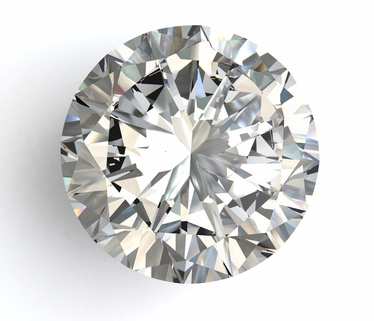Diamond Color Grading – A Quick Overview
There are many scales for grading diamond color, but the most popular one is that of the G.I.A. (Gemological Institute of America). It consists of letters from D to Z, and these letter grades are grouped into color ranges.

When it comes to color, you should know that white/colorless diamonds are pretty rare.
For example, diamonds graded D, E and F are at the top of the color grading scale and form the Colorless range.
The next group is the Near Colorless range, which consists of the letter grades G, H, I and J.
Diamonds graded with letters from K to Z have a faint to light yellow color.
The Most Common Diamond Color
When it comes to color, you should know that white/colorless diamonds are pretty rare, although they are very sought after.
In reality, most diamonds mined have a yellow or brownish tint.
Since people usually don’t like to wear diamonds that are noticeably yellow, stones that are visibly tinted are not common in jewelry stores.
So, the most common diamonds on the market are in the Near Colorless range, and more specifically, the stones with color grades H and I.
Click here to see a selection of H- and I-color diamonds.
H and I Colors Compared with Other Color Grades
Diamonds graded H and I are in the middle of the Near Colorless range – they do not have highly visible coloration, and at the same time, they are not as expensive as the more colorless stones.
That’s why the H-I grade is a popular choice for buyers.
This doesn’t mean that these stones are colorless, though. If put next to diamonds graded D, E or F, H-I diamonds will seem slightly more colored, but if looked at in isolation, they can pass for colorless stones.
Click here to see a collection of D/E/F-color diamonds.
Although someone with a really keen eye for colors may be able to spot the faint tint of a Near Colorless diamond, most people won’t notice it.
Stones that are Near Colorless are in the lowest color grade that can pass for white, depending on the setting and lighting.
Once you go past the J color, which is the lowest grade in this range, you enter into the yellow color range, and the stones graded K or lower will have a noticeable tint.
So, if you are looking for a diamond that is white to slightly off-white, don’t go below the G-H-I-J range.
When Should You Buy Near Colorless Diamonds?
Everyone wants a diamond that is as white as possible, but sometimes you just cannot afford to spend money on a colorless stone.
In such cases, settling for H or I color can be a good tradeoff between price and quality. Keep in mind that if you go past I color and buy a J-color diamond, for example, the tint may be noticeable.
On the other hand, if you are really sensitive to color, but you don’t want to go higher than the Near Colorless range, you should pick H or G.
It is worth noting that once you move up into the Colorless range, the price will go up dramatically as you will be paying a premium for that lack of color.
If you cannot afford the price tag of a D, E or F stone, but you still want the best color possible for your money, choose G – this color will get you as close as possible to the colorless grade without the need to pay a premium for it.
Important: Consider the Setting Before Buying
If you’ve decided to buy a Near Colorless diamond, you should know that the metal it is set in can have a huge impact on whether the stone’s tint will be noticeable.
Click here to browse diamond ring settings.
The whiter the setting, the more the color in the diamond will stand out. Therefore, the lower the color grade of your stone, the less suitable materials such as platinum or white gold will be for a setting, and you should consider a metal or alloy with more color instead.
In general, if you want to have your stone set in white metal, don’t go with diamond color grades lower than H. Colors such as I and J will most likely have their slight tint amplified by metals such as platinum or palladium, so if you have a diamond in this color range, yellow gold would be a better choice.
As a final note, you should remember that the cut of the diamond is very important for how prominent the stone’s color will be.
A good cut can bend and reflect light in a way that masks yellow tints, while a poor cut can make them stand out. That’s why you should always evaluate the appearance of each diamond based on how your eyes see it.
Where to Buy Diamond Jewelry?
We recommend James Allen (read review) because you can see a 360-degree video for any diamond before buying it.
Blue Nile is another reputable diamond retailer we recommend.














